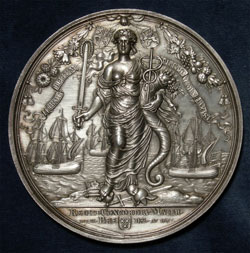ADOLPHZOON, Christoph: Netherlands, 1667, Silver, 72 mm
Obv: Hollandia, holding in her right hand a scepter terminating with
an eye, and in her left a spear with seven arrows representing the seven
provinces. She is trampling upon Discord (Envy) who holds a heart and snake.
A lion and a lamb are at Hollandia’s feet. Behind are seen burning ships at
left and undamaged ships at right, in a harbor showing the castle of Breda.
MITIS ET FORTIS (Gentle and Brave)
Exergue: PROCUL. HINC. MALA. BESTIA. REGNIS! (Far Away
from Here the Beast Is Too Morally Unprincipled for Reigning!) IUN: 22:
1667
Rev: Peace with long flowing hair, wearing a loose talaric chiton
and oak-wreath crown. In her right hand she holds a sheathed sword and in
her left hand a cornucopia. She is trampling upon arms, a crown and a money
bag. In the background is a fleet of sailing ships. Above is a celestial
hand holding shields of Britain and Holland. On Ribbon: IRATO BELLUM
PLACATO NUMINE PAX. EST.
Exergue: REDIIT. CONCORDIA. MATER. BREDÆ IUL. 31 Ao
1667. with the arms of Breda.
Signed: C.A.
Edge: NUMISMA. POSTERITATI. SACRUM. BELGA. BRITANNOQUE.
RECONCILIATIS. CUM. PRIVIL:ORDIN:HOLLAND:ET.WEST:
Rare
Ref: Van Loon II 534: MI i, 528/176; Pax in Nummis 257; MH 1921; Eimer
51/240; MCA Advisory Vol. 10, No. 5, pp.6-8; The Medal, no. 17 and no. 18,
1991, pp.10-22.
The Treaty of Breda was signed at the Dutch city of Breda
in 1667, ending the Second Anglo-Dutch War (1665–1667). This war involved
not only England and the United Provinces (the Netherlands) but also to a
lesser extent France and Denmark. It was brought to an end, in part, when
the Dutch Admiral Michiel de Ruyter broke the chains that had been placed by
the English in the river Thames and destroyed the English fleet anchored at
Chatham, which was subsequently burnt down. In the Peace of Breda, the
Netherlands ceded New Netherlands (now New York) to England, while England
ceded Suriname (formerly known as Dutch Guiana) to the Netherlands, while
leaving many other territorial disputes unresolved.
The issuance of the medal by the Dutch was surrounded in
controversy as Charles II apparently took offence to the imagery of the
English ships burning and the insulting inscription in the exergue of the
obverse of the medal. Some even suggest that this medal was a factor in
precipitating the Third Anglo-Dutch War (1672-1674), though others dispute
this tenuous connection. (See commentary in the MCA Advisory and
The Medal ).

